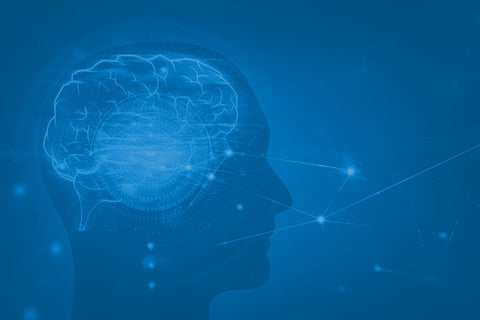
In today’s article, we are going to explore one of the most well-known and important neurotransmitters: serotonin.
As with gamma-aminobutyric acid, or GABA, serotonin can’t cross the blood-brain barrier to do its work. Although it can be consumed in the diet, serotonin must be synthesized at its site of action because it is almost fully metabolized prior to absorption.
Here, we will discuss the structure, function, and major roles of serotonin within the central nervous system, including how psychedelics modulate it, and beyond!
What is Serotonin?
Serotonin, or 5-hydroxytryptamine (5-HT), is one of the most well-known and well-studied neurotransmitters. It is involved in a wide range of neurological activities and modulates virtually all human behavioral processes, to the degree that drugs targeting serotonin receptors are used extensively in the psychiatry and neurology disciplines [1].
In animals such as humans, serotonin is synthesized from the amino acid L-tryptophan (an essential amino acid that must be obtained from the diet) in a reaction driven by the rate-limiting enzyme tryptophan hydroxylase.
It might surprise you to know that majority of the serotonin in the body does not reside within the brain or indeed the central nervous system (CNS). Instead, around 95% of the body’s serotonin is actually located in the gut [2]. There, special types of enteroendocrine cells called enterochromaffin produce serotonin, as well as serotonergic neurons of the myenteric plexus (a network of nerves that are responsible for bowel movements).
The remaining 5% of serotonin is synthesized by neurons, predominantly in the CNS but also in the islet cells of the pancreas, mammary glands, and adipose tissue [3]. These cells are not only sensitive to chemical and mechanical stimulation, but also to the signals from gut microbiota that stimulate the release of serotonin.
The body eliminates serotonin from the system by deaminating it to 5-hydroxyindole acetaldehyde before oxidation to 5-hydroxyindoloacetic acid, which is then finally excreted by the kidneys in urine [3].
The History of Serotonin
Serotonin was first discovered nearly 75 years ago [4] in an act of good fortune on the way to finding the cause of hypertension, yet this became one of the most pivotal discoveries in the field of neuroscience [5].
The formative work was completed in the 1930s by Vittorio Erspamer while he was still a student at the University of Pavia in Italy. He characterized enterochromaffin cells, a type of neuroendocrine cell in the digestive tract, using novel techniques that were not commonplace at the time. He found that an acetone isolate of these cells caused smooth muscle contraction, later naming the substance enteramine.
Later in 1948, Maurice Rapport, Arda Green, and Irvine Page from the Cleveland Clinic discovered a substance in blood serum with the ability to affect vascular tone, naming it serotonin [4]. Subsequent research would later confirm that enteramine and serotonin were different names for the same substance [6].
In the early 1950s, Betty Twarog successfully isolated serotonin in the mammalian brain and therefore established its importance as a neurotransmitter and its role in brain function [7]. Dilworth Woolley further fleshed out the role of serotonin in brain function and mental illness. These seminal findings would eventually herald the development of pharmaceuticals for depression, otherwise known as selective serotonin reuptake inhibitors (SSRIs). The first two developed in the 1970s were fluoxetine and sertraline.
In the decades since these classic studies, the exploration of both serotonin and its receptors has yielded new knowledge with relevance for pretty much all the major organ systems in the body.
Serotonin Receptors in the Brain and Beyond
Serotonin is involved in virtually every facet of human behavior, with multiple serotonin receptors expressed in all brain regions, and individual neurons themselves also expressing multiple receptors [1].
Over the last 30 years or so, our knowledge and understanding of serotonin has developed substantially. It is now thought that there are at least 15 separate serotonin receptors, nearly all of which are classed as G-protein-coupled receptors [8,9], that are located on the membranes of nerve cells in humans and other animals. The effects of serotonin are largely dependent on the type of cells and tissues that express these receptors, as the cellular activity of serotonin is fundamentally driven by receptor binding. These events then lead to further signaling activity within the cell itself.
How Serotonin Works
Advances in knowledge have revealed the diverse range of important roles that serotonin plays in many human organ systems outside the CNS. For example, it is implicated in the regulation of energy balance and food intake, the health of the GI tract, endocrine function, as well as cardiovascular and pulmonary physiology. This broad array of functions might partly explain the diverse side effects of serotonergic drugs, and therefore the ongoing development of receptor-specific pharmaceuticals.
In the CNS, serotonin is produced almost exclusively in neurons located in the raphe nuclei in the midline of the brain stem. Pretty much every cell in the brain is situated near a serotonergic fiber, and nearly all behaviors and many brain functions are regulated by serotonin. These behaviors are central aspects of the human experience, such as mood, perception, memory, anger, aggression, fear, stress, appetite, addiction, and sexuality [1,8]. Other effects within the CNS include motor control, sleep and circadian rhythms, body temperature, and respiratory drive, among others.
Each aspect of behavior is governed by multiple serotonin receptors, and each receptor is expressed in several regions of the brain. In this way, behavioral processes are modulated. To illustrate, anxious behavior is mainly governed by 5-HT1A and 5-HT2C receptors, yet the latter also regulates reward processing, locomotion, appetite, and energy balance in addition to anxiety. It is this trait of serotonin receptors that explains why pharmaceuticals targeting a specific 5-HT receptor influence multiple aspects of behavior [10].
In the resting state, serotonin is stored within the vesicles of presynaptic neurons. When stimulated by a nerve impulse, serotonin is released into the synapse to act as a neurotransmitter, binding in a reversible manner to bring about a nerve impulse on the postsynaptic neuron. After this, the serotonin is retrieved back into the presynaptic neuron to cease its activity, reused, or subsequently broken down.
Pharmacological Modulation of Serotonin
It is perhaps unsurprising given the diverse array of effects associated with serotonin that a major focus of drug development has been the modulation of its neurotransmission. There are SSRIs, tricyclic antidepressants, monoamine oxidase inhibitors, triptans, and fenfluramine, to name a few [1].
Although developed decades ago, SSRIs are still some of the most widely prescribed medications on the market today, especially for major depressive disorder, one of the most common mental health problems on the planet [11]. SSRIs work by blocking the reuptake of serotonin into neurons, as described above. This means that more serotonin is available to improve neuronal communication.
Despite this arsenal of pharmacological agents, serotonergic modulation is an undeniably complex endeavor. For example, depleting serotonin in an acute setting has little effect on healthy individuals, whereas the serotonin dysregulation seen in chronic disease (i.e., IBS or depression) can often be corrected to help address the problem by boosting serotonin in the brain.
The Influence of Psychedelics on Serotonin and its Receptors
Serotonin modulation is implicated in the pharmacology of several psychedelic compounds. Take LSD (lysergic acid diethylamide or "acid") for instance, a well-known psychedelic drug that was first synthesized in the 1930s. It acts primarily on the 5-HT2a receptor to exert its influence on perception and sense of self [12].
Elsewhere, new research has explored the safety of psilocybin (contained in "magic mushrooms"), a psychoactive serotonin receptor partial agonist, in human participants [13]. This recent study found no detrimental effects on short- or long-term cognitive function or emotional processing. Psilocybin is dephosphorylated after ingestion to psilocin, a substance virtually analogous to serotonin that binds to 5-HT receptors and initiates a similar response to that of the neurotransmitter [14].
Lastly, DMT (dimethyltryptamine) is a substance associated with the ayahuasca brew of many Amazonian tribes. As with LSD, it acts on the 5-HT2a receptor, to which a large degree of its psychedelic effects can be attributed, however, it also has an affinity for multiple other 5-HT receptors [15].
The action and affinity of psychedelic compounds for serotonin receptors — and their similarity to serotonin itself — is, therefore, a key aspect of their pharmacology and mechanisms of action within the brain, thus explaining the familiar and well-known mental (i.e., far out!) effects of these substances.
References
-
M. Berger, J.A. Gray, B.L. Roth, The expanded biology of serotonin, Annu Rev Med. 60 (2009) 355–366. https://doi.org/10.1146/annurev.med.60.042307.110802
-
M.D. Gershon, J. Tack, The serotonin signaling system: from basic understanding to drug development for functional GI disorders, Gastroenterology. 132 (2007) 397–414. https://doi.org/10.1053/j.gastro.2006.11.002
-
T. Guzel, D. Mirowska-Guzel, The Role of Serotonin Neurotransmission in Gastrointestinal Tract and Pharmacotherapy, Molecules. 27 (2022) 1680. https://doi.org/10.3390/molecules27051680
-
M.M. Rapport, A.A. Green, I.H. Page, Serum vasoconstrictor, serotonin; isolation and characterization, J Biol Chem. 176 (1948) 1243–1251.
-
P. Whitaker-Azmitia, The Discovery of Serotonin and its Role in Neuroscience, Neuropsychopharmacology. 21 (1999) 2S-8S. https://doi.org/10.1016/S0893-133X(99)00031-7
-
W. Feldberg, C.C. Toh, Distribution of 5-hydroxytryptamine (serotonin, enteramine) in the wall of the digestive tract, J Physiol. 119 (1953) 352–362. https://doi.org/10.1113/jphysiol.1953.sp004850
-
B.M. Twarog, I.H. Page, Serotonin content of some mammalian tissues and urine and a method for its determination, Am J Physiol. 175 (1953) 157–161. https://doi.org/10.1152/ajplegacy.1953.175.1.157
-
W.K. Kroeze, K. Kristiansen, B.L. Roth, Molecular biology of serotonin receptors structure and function at the molecular level, Curr Top Med Chem. 2 (2002) 507–528. https://doi.org/10.2174/1568026023393796
-
J. Hannon, D. Hoyer, Molecular biology of 5-HT receptors, Behav Brain Res. 195 (2008) 198–213. https://doi.org/10.1016/j.bbr.2008.03.020
-
M. Giorgetti, L.H. Tecott, Contributions of 5-HT(2C) receptors to multiple actions of central serotonin systems, Eur J Pharmacol. 488 (2004) 1–9. https://doi.org/10.1016/j.ejphar.2004.01.036
-
M. Ghaffari Darab, A. Hedayati, E. Khorasani, M. Bayati, K. Keshavarz, Selective serotonin reuptake inhibitors in major depression disorder treatment: an umbrella review on systematic reviews, Int J Psychiatry Clin Pract. 24 (2020) 357–370. https://doi.org/10.1080/13651501.2020.1782433
-
T. Lawn, O. Dipasquale, A. Vamvakas, I. Tsougos, M.A. Mehta, M.A. Howard, Differential contributions of serotonergic and dopaminergic functional connectivity to the phenomenology of LSD, Psychopharmacology (Berl). (2022). https://doi.org/10.1007/s00213-022-06117-5
-
J.J. Rucker, L. Marwood, R.-L.J. Ajantaival, C. Bird, H. Eriksson, J. Harrison, M. Lennard-Jones, S. Mistry, F. Saldarini, S. Stansfield, S.J. Tai, S. Williams, N. Weston, E. Malievskaia, A.H. Young, The effects of psilocybin on cognitive and emotional functions in healthy participants: Results from a phase 1, randomised, placebo-controlled trial involving simultaneous psilocybin administration and preparation, J Psychopharmacol. 36 (2022) 114–125. https://doi.org/10.1177/02698811211064720
-
D.E. Nichols, Hallucinogens, Pharmacol Ther. 101 (2004) 131–181. https://doi.org/10.1016/j.pharmthera.2003.11.002
-
T.S. Ray, Psychedelics and the human receptorome, PLoS One. 5 (2010) e9019. https://doi.org/10.1371/journal.pone.0009019





Comments (0)
There are no comments for this article. Be the first one to leave a message!